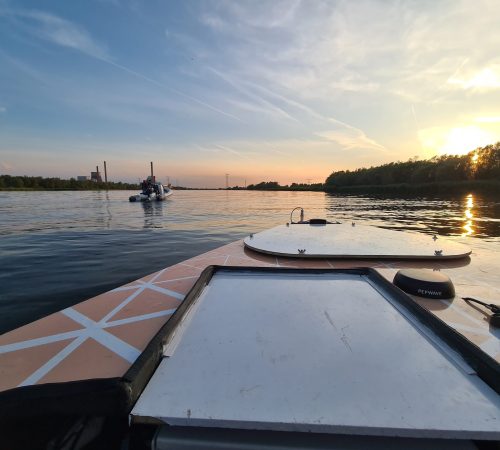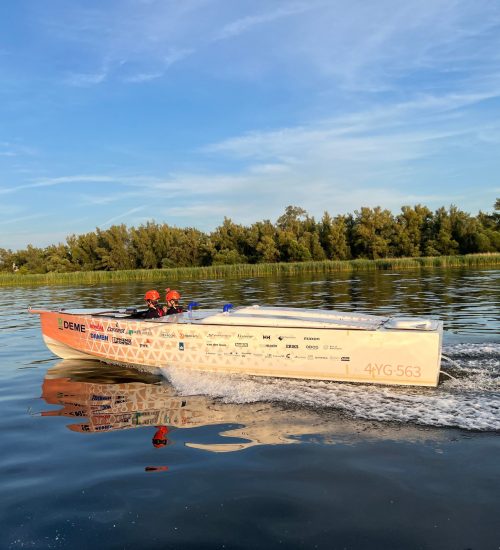Newsletter
June – A foiling hydrogen-powered boat
Over the past few weeks, we have made our first metres with Aurora. She planes very stable and you can see the effect of the chine beautifully. The spray is immediately directed downwards and generates a lot of lift. To maximise the testing time with Aurora, we work in different shifts. In the past month, we tested the hydrogen systems on full power. After a couple of tries the system was reliable enough to start testing with high speed tests on the water. Aurora sails exceptionally stable, especially when planing. This enabled us to sail safely at a top speed of 42 km/h!
Height control
After those tests, we could start with the height control tests. This is the most exciting but also the most tricky part of testing since every part needs to work together seamlessly. The electrical system must be trustworthy, as well as the foil actuation (and other) software. Mechanically the hull, foil actuation system and struts must withstand all the hydrostatic and -dynamic forces when foiling. Because there are waves we need to adjust the angle of our hydrofoils to keep sailing stably. We have implemented a PID controller which needs to be tuned, we do this ourselves. The PID is like the settings of a computer, we have to alter the settings till the system doesn’t over or under react. So by tuning the parameters for height, pitch (rotational motion around the side-to-side axis) and roll (rotational motion around the longitudinal axis) we are creating a stable foiling hydrogen-powered boat.
Friday the 2nd of June marked a significant moment for our team as we embarked on testing our height control system. During our height control testing, we achieved a remarkable milestone as we successfully foiled for the first time! We worked really hard to make this happen and we couldn’t be more proud that we achieved part of our goal by building a foiling hydrogen-powered boat. However, this thrilling moment transitioned into a challenging situation when unstable behaviour of the boat led to damage. The boat stayed afloat, allowing us to safely lift it out of the water. Thanks to the pro-active responses of the team members no one got hurt.


Of course, this recent situation was a setback for our entire team. It was terrible to see our boat, which we had worked on so hard over the past year, get damaged. Despite this, we were not going to give up. We, as a team, immediately started planning the repair, and we are confident in our ability to overcome and emerge stronger than ever! The whole team worked very hard to repair everything that was damaged, and in just 10 days we were able to get back to testing again!
During the last two weeks we have worked diligently to restore the functionality of the system after the incident. Some parts broke down, and everything had to be thoroughly tested again to ensure the reliability of the components. The buffer was revised to make it more robust.
We also conducted some tests for the height control and there were significant changes made to the code based on the results. The display of the pilot is also updated to provide more informative feedback and the steering mechanism is improved so the pilot can handle the height control of the boat easier.
Monaco
Besides sailing in Aurora, our trip to Monaco is also getting closer and closer. The hotels for the trip have been booked and we are staying near the port. Over the next two weeks, we will be preparing the finishing touches of the logistics for our trip and our stay in Monaco. That way, we will arrive at the start fully ready for what’s to come.
We are in good spirits for the Monaco Energy Boat Challenge and are looking forward to competing in the Open Sea Class. The first challenge we have to complete in Monaco is the manoeuvrability challenge. For this part we’ll need to complete a certain route as fast as possible with a maximum speed of 3 knots which is about 5,5 km/h. Because there is a maximum speed it is all about the pilot’s and the boat’s manoeuvring ability.
The second challenge we’ll face is the endurance challenge. This challenge allows us to really show the potential of hydrogen and the difference between hydrogen and battery powered boats. All boats will get four hours to cover as much distance as possible. Because batteries are so much heavier than hydrogen, we can take more energy with us and therefore sail further.
The last challenge is the speed challenge, this will be intriguing because batteries can release more energy in a short time compared to hydrogen. This means that we’ll need to foil to improve our chance of winning. Monaco is approaching very fast so at the moment we are on the end sprint and working hard to get the best out of the boat.

Newsletter
For the coming weeks we will be testing the boat in the water and we’ll prepare for the race. The next newsletter will be out in two weeks when we’re in Monaco! Do you know someone who is not yet receiving this newsletter but would like to? Send an email to exposure@hydromotionteam.nl or click on the link below. Via the link, you can enter an email address and will be asked to confirm via Mailchimp’s email. Feel free to send any comments or questions to exposure@hydromotionteam.nl
See you next time!

